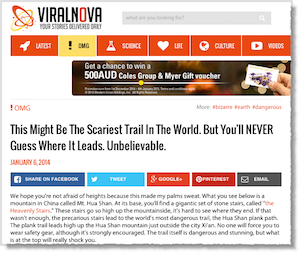How to be a Content Marketing Superhero – 14 Types Of Media You Need To Master
Campaign marketing is the essence of any traditional promotion for almost any brand or business. Summer sales, Easter sales and stock clearance sales. The list goes on.
But there is another type of marketing that is often overlooked.
Continuous marketing.
Other naming options? “Marathon” marketing, “Forest Gump” marketing and “Always On” marketing. On the global web that never sleeps this content marketing strategy is key to success.
Silence is not golden for content marketing superheroes who want to stand out and save the world and their business.
Table of Contents
Google and social networks don’t tolerate silence
Think you can just use content every now and then? A blog once a month, a Facebook post once a week and Twitter every second day?
Do that and the search engines will think you are irrelevant. The obsessed social fans will think you have taken a holiday or maybe even died.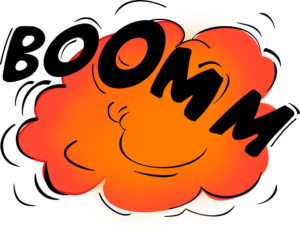
So, campaigns are still vital but “always on marketing” is now essential.
The content marketing beast needs to be fed. The search engines require tickling and the prospects need to be reminded that you are alive and kicking online.
Content needs to move to get discovered.
Brand building requires more than unique content, mind bending insights or ideas with gravitas. It needs to ripple across the web. Dropping into inboxes, events, LinkedIn and online conversations.
Just having it sit on your site is not enough. It needs to go on a journey.
Content has many goals
It was a conversation in Dublin over a pint of Guinness.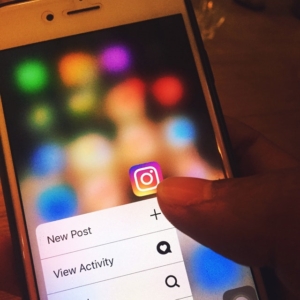
A discussion about the transforming content landscape. Led by Buzzfeed and Snapchat. In a noisy world that has the human attention span below that of a goldfish we are almost required to resort to the inane to capture the initial response.
Now we need to add a bit of augmented reality. Pokemon Go. Also add a dose of scarcity. Content that only lasts 24 hours, Snapchat and Instagram stories.
Read and view it before it’s gone!
Get your attention with cats and babies and then I will send the serious stuff!
So content has a few goals to achieve.
“Content needs to educate, inform, entertain and inspire”6
Content creation tension
Content marketing has a constant tension between what can be seen as two polar opposites. Attention seeking and trust. But they have to work together.
Buzzfeed and the tabloid press are kings of the clickbait headlines that begs for attention. Trustworthy quality content – In traditional media, this is investigative journalism and all that surrounds it. The marketer needs to access both types of tactics.
As content marketers, we often want to get that piece of content to go viral. So how far should we go with using babies and cat videos? There is no right or wrong answer.
So for the sake of simplicity, we can break up content marketing into 3 types.
A: Traffic Generation Content – Tempt people to click through to your website, blog or landing page and share.
B: Engagement Content- The strategic use of educational, informative, entertaining and inspiring content that builds credibility, trust and linking
C: Conversion Content– Capturing those all-important leads and producing sales is the real end game for traffic and engagement. Otherwise, it is just noise.
But the reality is that they don’t stand alone and they are often woven together in a matrix of attention, engagement and a call to action. Although some are better than others at traffic generation and some stand out for engagement.
Let’s dive in and discover what are the different types of content that will help make you a superhero for your brand.
Traffic generation
Web traffic is the foundation for success online. It is the oxygen that a blog, a website needs to grow, survive and thrive.
So what types of content can drive traffic?
1. Photos and images
The mobile obsessed world we live in has made this a core tactical skill set for the modern marketer. Using screenshots, authentic and personal content. Images that touches hearts and minds. Pictures that pose a question, pique our curiosity or intrigue.
 Buzzfeed’s photo of a young girl standing in front of a burning house with a devilish grin is one of those.
Buzzfeed’s photo of a young girl standing in front of a burning house with a devilish grin is one of those.
According to knowyourmeme.com, the original photo was posted to Buzzfeed on October 27th, 2008 with a follow-up post the next day highlighting the best derivatives, followed by similar posts on Digg, TrendHunter, eBaum’s World Forum and Best Week Ever. Over the years, it appeared on Cracked and also the Huffington Post.
Millions of views.
Photo source: Knowyourmeme.com
2. GIF’S
Using acronyms without explanation is babble and gobbledygook.
So what does GIF mean? An animated GIF is a “Graphics Interchange Format” file that is a graphic image on a Web page that moves. That’s it.
Attention is in short supply and content marketers need all the tools and tactics they can nab for standing out.
Moving images, automatic starting and pop-ups can be annoying. But there is one thing you can’t argue with. They grab you attention.
GIF’s sit in this category.
GIFs can be used on Twitter, included inside banners and even in email campaigns.
Dell ran a GIF centric email campaign and discovered that it increased engagement on every level.
Source: Marketingsherpa.com
Compared to its previous campaign benchmarks without GIFs these were the results :
- 6% increase in open rate
- 42% increase in click rate
- 103% increase in conversion rate
- 109% increase in revenue
The part I like is the 109% increase in revenue. That’s what I call a boost in ROI.
If you want to start using GIF’s today here are 3 free resources.
 3. Mini-infographics
3. Mini-infographics
These work well on Twitter, Instagram and Pinterest. Embed them in blog posts and people love to share them.
It’s light snackable content.
It’s the start of brand awareness building. Its the equivalent of the baby or cat image for the quasi intellectuals.
This one tweet with an infographic received 70 retweets, 26 likes and 26 link clicks for a total of 126 total engagements. It generated those all-important clicks to the blog and sharing.
4. Headlines
Headlines are the shortest type of content that we have in our marketing toolbox.
But don’t be beguiled by what at first seems a simple skill that you should ignore. They are maybe your most important tactic. It’s where the customer seduction begins.
David Ogilvy the “Advertising Guru” was known for agonizing over the headline.
Why?
Because 5 times more people read the headline than the article, advertisement or your post.
What are some headlines that work?
There are many formulaic headline types. And these work for ebook titles, blog posts and news articles. They are required for video titles, white papers and even downloadable PDF’s.
Here are some to try out.
- Large listicle – “The Ultimate Guide on How to get More Blog Traffic: 100+ Tips and Tactics“
- Curiosity gap – “He Was Found Freezing And Dying. Yet Somehow The Last Photo Made My Entire Year”
- How To’s – “How to Grow an Email List: 3 Case Studies on How Silly Online Quizzes Produce Serious Business Leads“
- Negative – “Why You Should Forget Facebook“
- Benefits – “5 Extremely Actionable Tips to Improve Your Content Writing“

ViralNova’s headline specialty is the curiosity gap tactic. You might not want to take their tactic that far. But the use of people’s innate curiosity to drive traffic and engagement is a proven winner.
Most boring industries struggle to write those attention-grabbing headlines. It’s seen as superficial and below the dignity of a serious industry. But it’s a tactic you can’t ignore if you want to make it bigger online.
More resources:
22 Headlines That Went Viral. Have These Marketers Cracked the Code?
10 Content Marketing Lessons from The World’s Fastest Growing Websites
Engagement
Traffic is one thing and cats, GIF’s and babies photos have maybe got your audience’s attention. Now it’s time to keep them on the page or start to believe that you are indeed a superhero.
What types of content have an edge in achieving this marketing goal?
5. Long-form content
When digital marketers started to discover the power of content to improve SEO they started posting high volumes of blog posts. This was the quantity part of the SEO equation. But this also led to poor quality. Google then adopted its algorithms to reduce their effectiveness. It added tweaks that gave more value to quality content long-form content.
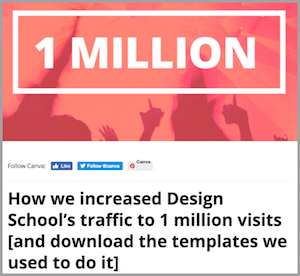 Today we are seeing the rise of long-form content from 1,000 words plus that have 2 major benefits for brand building and marketing optimisation
Today we are seeing the rise of long-form content from 1,000 words plus that have 2 major benefits for brand building and marketing optimisation
- Positions your brand as the expert in your industry
- It impacts search engine optimisation and link building for building website authority.
Great examples of this tactical content are sites like Buffer, Neil Patel and Canva.com. This post below on the “Design School” blog on Canva is over 3,000 words
On our blog, we have a standard of 1,000 plus words for all guest posts. Often they are 1,500-2,000 words.
6. Short videos
These can entertain, educate or sell. My blogging course on Udemy was built on videos where were none went over 7 minutes. This was based on their engagement research.
Other research has shown that 2 minutes is optimum for maximizing engagement when you are not training but maybe just entertaining.
My keynote speaking showreel is no longer than 2 minutes.
Buzzfeed has taken social short video to a whole new level with it’s new division – BuzzFeed Motion Pictures.
Frank Peretti (Buzzfeed’s CEO) said the company’s “little experiment” began when Facebook started allowing autoplay for in-feed videos.
A big part of this experiment is their “Tasty” Food network and is a great example of pushing your content to its own platform and also publishing on the world’s biggest social network.
It is maybe the top-performing video channel on the planet with over 360 million viewers a month. The Facebook auto-playing videos are mostly under 2 minutes.
This video has nearly 15 million views and counting.
7. Live streaming video
Thinking like a publisher for many means producing a book, a magazine or a newspaper. Then it expanded to bloggers but the game has got a lot bigger. Innovative content marketing has expanded the range to much more.
Welcome to “Live Streaming Video”
Live streaming video is one of the hot content trends. It sort of started with Google+ hangouts, Periscope hit the scene about a year ago and now Facebook Live is now trying to eat everyone’s lunch.
A fun example of what could be called a “highly engaging” Facebook Live video is Candace Payne’s “Chewbacca mask” video where she tries it on in her car in the parking lot and laughs herself stupid after buying it at Kohl’s.
It currently has received over 160 million views. So from engagement to sales. The mask sold out at Kohl’s, Walmart, Target and ToysRUs.com
What is great about this type of content that moves from engagement to sales is that it is not overproduced and it’s not about selling.
It’s about starting with engagement. But there is no guarantee that it will go viral as this did.
8. Podcasts
Engagement with the written word is one thing but listening to someone’s voice is visceral, magnetic and very human. That is the power of the podcast.
But Podcasts as content do not travel well on the social web. They are maybe close to the bottom of the sharing type content bucket. So building an audience first on either social or email with other more viral shareable content is recommended.
So for building trust, credibility and engagement they are hard to beat. Pat Flynn is one of the masters of this content genre.
9. Crowdsourced content
What is the biggest challenge for a content marketer?
It is a simple two-word sentence. Content creation. Creating quality content takes time and resources.
One solution? Technology.
Software as a service platforms has made this possible to do at scale. Because at the end of the day content creation is one of the biggest challenges for bloggers and businesses.
Second solution? Trade attention for content.
If you have built up a blog or website that already has traffic then you can give that all-important traffic and attention to other writers and new bloggers. This is guest writing. Often done for free to help up and coming bloggers and marketers to ride on the back of a credible site that already has traffic.
Conversion
This is a big topic but we will distil it into the top types of content reknown for turning traffic into leads. Here are five that you need to master as a professional digital marketer.
10. Landing pages
Landing pages are often not seen as content. But they are an optimal intersection of a range of multimedia. Headlines, copywriting, videos, color and images. And with a call to action that is designed to generate a response.
To produce the right reaction they can use a range of tactics including scarcity, social proof and tempting value.
If you want to generate a tangible return on investment for your online marketing efforts then these are “ROI- 101”. Essential and necessary. They can be short and long.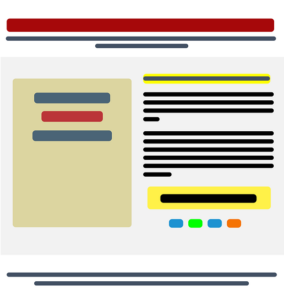
Where do you use them? Everywhere.
Ebook opt-ins, registering for webinars, video sales letters and when launching a new product, an online course or a new book
Simple can work well.
SumoMe recommends that you use very minimalist landing pages for capturing email optins. Sometimes as marketers and designers we try and be too clever. You’re just trying to achieve one thing. An email sign-up.
It’s not complicated.
Landing pages in the past were major projects and expensive to design and create. Hire a designer, hunt down a copywriter, invest $2,000 and then wait for weeks for the developer to code the web page. That was the norm. Today with technology like Leadpages you can create them in minutes.
You can also see what are are the top-performing landing pages based on the data. And the conversion rate is the metric you need to be watching.
11. Webinars
Educating and building credibility and engagement at scale is what webinars do well. They are a combination of verbal and visual content. As a business, you can use them to educate and even make special offers at the end of the presentation.
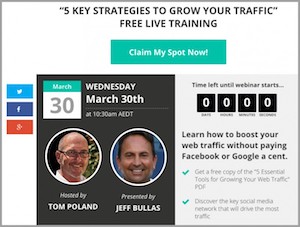 But they can be used to supercharge your conversions. When you collaborate with an influencer or non-competing business partner they are one of the fastest ways to grow an email list. So how does that work?
But they can be used to supercharge your conversions. When you collaborate with an influencer or non-competing business partner they are one of the fastest ways to grow an email list. So how does that work?
You provide the content (the webinar slide deck) and they then market it to their email list and social networks. To attend the webinar they have to enter their email address. You can add several hundred prospects to you customer database in a few days with this conversion content tactic.
Here is an optimum design that I used from Leadpages to create the landing page for the webinar that I ran with a good friend of mine Tom Poland.
What you will need:
- Email marketing platform – MailChimp, Aweber or Infusionsoft
- Webinar software or app – GoToWebinar or WebinarJam
- Leadpages landing page – You can use the GoToWebinar registration page but it is far from optimum
- Powerpoint or Apple’s Keynote for the visuals
12. Ebooks
Ebooks are still one of the top-performing lead magnets.
I have found that as a content opt-in tactic they surpass almost any other type of content. The downside is that a good one takes time to write and design.
The best performing ebooks tend to be created around one of the biggest pain points that your prospects and potential customers have. Often for a small business in a digital world, it is getting traffic to your website.
My top performing ebook is “101+ Tips to Grow Your Web Traffic” that has been downloaded over 40,000 times. So…if you haven’t got it then you can grab it >>> HERE
13. Copywriting
The ultimate goal of copywriting as used in advertising is to sell products. They are at the sharp end of the content marketing funnel.
Great copywriting will touch hearts and minds. It gains attention. It invokes or suggests a response.
It is required for landing pages, blog posts, tweets and even sent with that image or photo (just to name a few). But email is one of the the core media types that require skilled copywriting. It uses the power of words alone to cut through the clutter that bombards us every day.
It was an “aha” moment for me when after writing an email to market a conference I received a reply I will never forget.
The email:
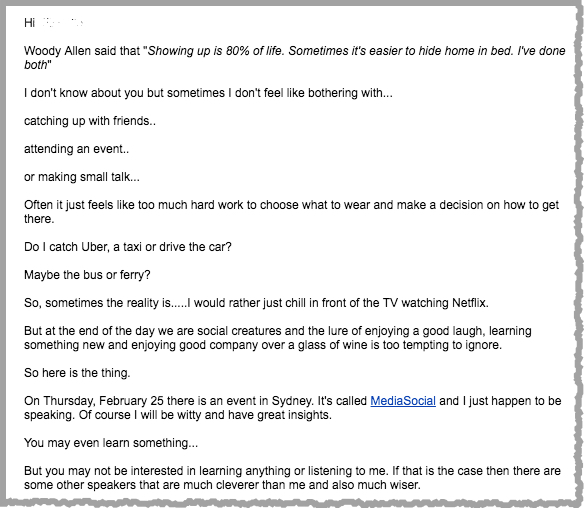
The response:
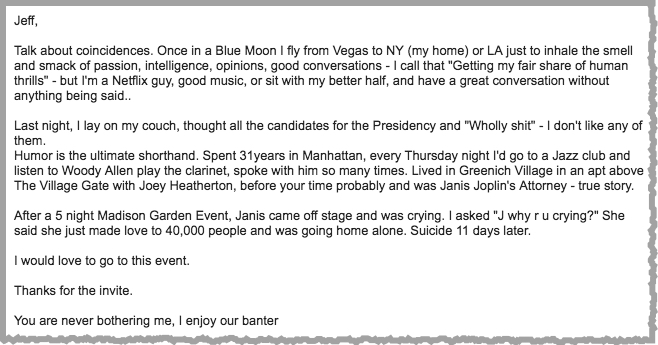
It was the best “No” I had ever received.
But getting an email in return as if you had written to them alone is when it seems worthwhile. That is the magic of copywriting that touches a human heart.
And that is the true art of sales copywriting.
14. Interactive content
It was in 2008 I stumbled upon Hubspot and discovered their website assessment  tool. I registered and checked it almost every day to see how my blog was progressing. It was the most powerful engagement content I have ever discovered then and since.
tool. I registered and checked it almost every day to see how my blog was progressing. It was the most powerful engagement content I have ever discovered then and since.
According to ION interactive Quizzes, calculators and assessment tools are some of the top types of interactive content and Buzzfeed uses them a lot.
Let’s have a closer look at quizzes.
Quizzes are one of the most shared types of content on the web. According to BuzzSumo data, the average quiz gets shared 1,900 times. And one of the top shared quizzes (with 4 million shares) was “What Color Is Your Aura”
One of Buzzfeed’s most popular with over 2 million views is “Why Are You Single”
However, they have a more serious superpower.  Converting traffic and sharing into an email. So how effective are they in turning traffic and engagement into leads and sales?
Converting traffic and sharing into an email. So how effective are they in turning traffic and engagement into leads and sales?
According to a case study where Media Vision Interactive ran an Interactive content-focused campaign where they increased their warm leads by 300%.
More resources:
How to Grow an Email List: 3 Case Studies on How Silly Online Quizzes Produce Serious Business Leads
One last thing
You may have the best images, articles and videos in the world but if no one can see or find your content then you are wasting your time.
Content marketing is two words and content is just one of them. To create, publish and start hustling.
Want to learn more about getting traffic to your awesome content and website? Double your visitors?
Grab your free copy of “101+ Tips To Grow Your Web Traffic Without Paying Google or Facebook a Cent” >>>> HERE
About the author: Jeff Bullas
 Jeff is an entrepreneur, blogger, author, marketer and speaker and works with personal brands and business to optimize online personal and company brands with emerging technologies, content, social media technologies and digital marketing. He has spent most of his career involved with information technologies, telecommunications and the web.
Jeff is an entrepreneur, blogger, author, marketer and speaker and works with personal brands and business to optimize online personal and company brands with emerging technologies, content, social media technologies and digital marketing. He has spent most of his career involved with information technologies, telecommunications and the web.

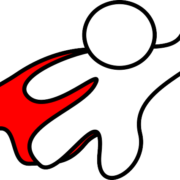
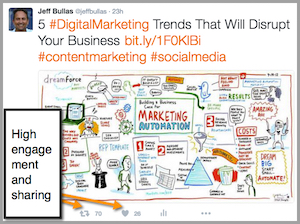 3. Mini-infographics
3. Mini-infographics